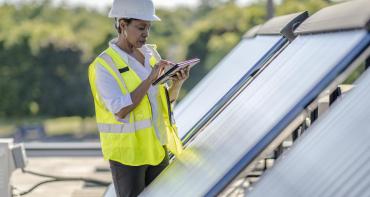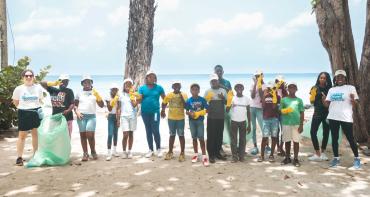With trillions of pieces of plastic littering oceans, threatening ocean and life and economic opportunity, drones, satellites and artificial intelligence (AI) are informing countries about how to tackle this growing global emergency. A recent Commonwealth Clean Ocean Alliance webinar focused on these innovative technologies for monitoring and reducing marine pollution.

Over 170 participants from 39 countries joined the discussion, titled Using remote sensing for detecting marine plastic pollution: Need, barriers, challenges, and innovative technologies.
Opening the session, Dr Jane Collins, Ocean Governance Advisor at the Commonwealth Secretariat, underscored the urgency of coordinated action and said:
“Marine plastic pollution continues to pose one of the most urgent and visible threats to the health of our ocean, with devastating consequences for marine life, coastal economies, and human well-being. For the Commonwealth, home to half of the world’s coral reefs and many small island and coastal states, addressing plastic pollution is not just an environmental issue, but also one of economic development.”
Bridging the data gap
In partnership with Innovate UK Business Connect, the event drew on work commissioned under the Smart Sustainable Plastic Packaging Programme, exploring how advanced technologies can bridge existing data gaps and support evidence-based policy and action.
Luca Budello, Geospatial Insights Lead at Innovate UK Business Connect provided an overview of initiatives to improve marine litter observation and stressed that reliable, real-time data is essential for evidence-based action. He said:
“We lack information on the ground. Our goal is to bridge this gap through space-based and in situ monitoring, working with partners to develop tools that countries can readily apply.”
Case studies in innovation
Participants heard from leading innovators across the Commonwealth who are applying novel methods to monitor marine litter. Alasdair Davies, Technical Director of the Arribada Initiative, demonstrated how low-cost GPS trackers can trace the movement of plastic waste across waterways and coastlines, identifying pollution sources and informing clean-up strategies. Andre Valente, Head of Space Systems and Applications at the Atlantic International Research Centre, shared how data from satellites can contribute to quantifying temporal trends – the patterns or changes over time - of plastic pollution and evaluate mitigation measures.
Kostas Topouzelis, Co-Founder and CEO of SciDrones, presented the Coastal Marine Litter Observatory (CMLO). This is an AI-powered drone platform that detects, classifies, and maps litter in near-real time. To date, CMLO has surveyed more than 340 kilometres of coastline across 14 countries.
A panel discussion explored opportunities to scale these innovations, integrate diverse datasets, and foster international collaboration.
Call to Action
The webinar took place against the backdrop of major international milestones for ocean and climate action. The Apia Commonwealth Ocean Declaration commits member countries to ending plastic pollution, strengthening ocean-climate action, and securing at least 30% marine biodiversity protection by 2030. The insights shared in this webinar also support ongoing negotiations toward a Global Plastics Treaty and align with the Commonwealth’s ambition to accelerate progress in reducing marine plastic pollution.
The Commonwealth Clean Ocean Alliance brings together 35 member countries committed to ending plastic pollution by 2040 through knowledge sharing, capacity building, and international cooperation.
Keep up on climate news with the Commonwealth at COP30
Media contact
-
Suné Kitshoff Senior Communications Officer, Communications Division, Commonwealth Secretariat
- M: +44 7740 450 901 | E-mail



